Catalogue > Search
Results for : Tout le catalogue
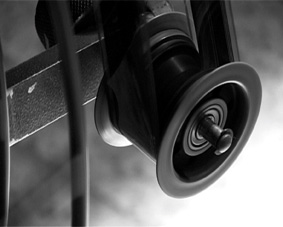

Carles Asensio Monrabà
CINEMA MUNDIAL 1957-2007
Experimental doc. | dv | color and b&w | 21:0 | Spain | 2008
Grandeur et décadence d?un petit commerce de cinéma. Cinema Mundial 1957-2007 is a 21-minute short film that reflects the life of the celluloid via a digital camera and reveals the real essence of cinema. Cinema Mundial 1957-2007 shows the magnanimity and decadence of a small commercial movie theater in Sant Celoni, a village located in the province of Barcelona. In the projection room, Félix, the projectionist, and Juan, his assistant, carry out their work using traditional methods. They keep on working even though they know that it might be their last showing due to the warnings on the imminent closing of the movie theater. Some months later, we can still appreciate the demolition of this movie theater and its marks recall a history and a memory of cinema.
Carles Asensio Monrabà, was born on September 30th 1979 in Sant Celoni, a village in the province of Barcelona His studies and audiovisual works were carried out between Barcelona and Madrid. In Barcelona, he studied Direction in the Centre d?Estudis Cinematogràfics de Catalunya (CECC); after that, he got a grant by the Escuela de Cinematografía y Audiovisuales (ECAM) to study in Madrid. Among his fiction short films stands out Revival (finalist in the Fifth Edition of Notodofilmfest), Kiss me, fool or For Ever Lola (a false documentary that pays tribute to Basilio Martín Patino.) Other audiovisual works fall within the category of experimental documentaries, such as the short film Cinema Mundial 1957-2007 or 01 one, a feature film project inspired in Abbas Kiarostami´s film-making experience with his film Five. His artistic interests led him to study at the Col·legi de Teatre in Barcelona; in connection with theater, he establishes the group called Irma Vep in 2007, together with the actress Clara Macías Carcedo, who also takes an active part in his audiovisual works. In 2008 he takes the Documentary Master?s Program at Pompeu Fabra University in Barcelona. The Museum of Modern Art (MoMA) in New York city has just acquired Cinema Mundial 1957-2007 for its Permanent Collection. This short film was selected by New Directors/New, organized by MoMA and the Film Society of Lincoln Center to be screened in the last edition which took place in April 2008. As a result of his participation in this Film Festival, the Museum showed its interest in acquiring a copy of his work for its Permanent Collection, where we can find some of the most representative works from the world history of film. MoMA was the first museum that acquired films as works of art for debating and broadcasting purposes. In its collection we can find films by Charles Chaplin, Eisenstein, F.W. Murnau, John Ford, Carl T. Dreyer, Fritz Lang, Orson Welles, Roberto Rossellini, Federico Fellini, Yasujiro Ozu, Jean-Luc Godard, Andy Warhol, Stanley Kubrick, Francis F. Coppolla, Lars von Trier, Jia ZhangKe, David Lynch or Jim Jarmusch. Up until now, the only Spanish film-makers included in this collection were Luis Buñuel: El perro andaluz, La Edad de Oro, Los Olvidados, Belle de jour and El discreto encanto de la burguesía and Pere Portabella: Vampir cuadecuc and El silencio antes de Bach. In March 2009, his short movie was selected to be screened at the International Film Festival of Las Palmas de Gran Canaria (Canary Islands) as part of the Cinema Cycle DGeneraciones II. Presently, Carles Asensio is writing a script for a fiction feature film and is working in the creation of video art works based on 20th Century Painters such as Francis Bacon and screen-art.

Karimah Ashadu
Machine Boys
Experimental video | 4k | color | 8:50 | Nigeria, Germany | 2024
“Machine Boys” is a short film which explores the informal economy of motorcycle taxis; colloquially known as “Okada”, in the mega city of Lagos. Banned due to the government’s inability to regulate it, “Machine Boys” portrays a hardy group of bikers who continue this work, seeking to attain financial autonomy and independence. “Machine Boys” dwells on the consequences of this ban, meanwhile portraying the daily rituals and challenges faced by Okada riders. The riders embody though their stylish attire, and self-assured, powerful behavior, a particular branch of masculinity, and in this performance a beautiful vulnerability emerges, questioning Nigeria’s patriarchal culture. Through this exploration of Nigerian patriarchal ideals, Ashadu relates its performance of masculinity to the vulnerability of a precarious class of workers. With its innovative, cutting-edge style and sartorial references, it engages in a dialogue around post-colonial informal economy structures in Nigeria, as well as opening a window into the socio-cultural nuances of its most populated city.
Karimah Ashadu (b. London 1985) is a British-born Nigerian Artist and Film Director living and working between Hamburg and Lagos. Ashadu’s work is concerned with labour, patriarchy and notions of independence pertaining to the socio-economic and socio-cultural context of Nigeria and its diaspora. Her work has exhibited and screened at institutions internationally, including the 60th Venice Biennale, where she was awarded the Silver Lion for a Promising Young Participant in the International Exhibition. She has shown at Kunsthalle Bremen, Tate Modern, London, Secession, Vienna, Kunstverein in Hamburg, South London Gallery, London, Museum of Modern Art, New York and Centre d’Art Contemporain Genève. Ashadu is the recipient of other awards such as the Prize of the Bötterstraße in Bremen (2022) and the ars viva prize (2020). Public collections include MoMA, the City of Geneva Contemporary Art Collection and the Federal Collection of Contemporary Art, Germany. She was named Abigail R. Cohen 2021 Fellow at the Columbia Institute for Ideas and Imagination, Paris. In 2020, Ashadu established her film production company Golddust by Ashadu, specialising in Artists’ films on black culture and African discourses.
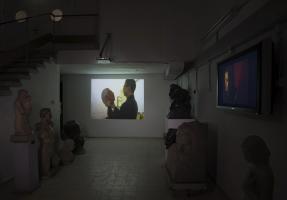

Oreet Ashery
Back in 5 minutes
Art vidéo | dv | color | 8:7 | United Kingdom | 2007
Back in Five Minutes is a short self contained ?art world thriller? with no resolution. A curator visits an artist?s studio and finds it empty, the only reminder of the artist, apart from their work, is their mobile phone and a note saying that they have gone to get milk and biscuits and will return shortly. The curator explores the studio with a sense of invasiveness and finally comes across a bag with newly bought milk and biscuits. Later on in a bed room conversation the curator speculates that the studio visit was in fact a staged act orchestrated by the artist in order to make the curator part of her work. His partner suggest that something might have really happened to the artist and that they should contact the gallery. Back in Five Minutes explores the potentially threatening gap between life and art, private and the professional suspicions, the status of object-based art versus performative art, and power dynamics in the art world.
Oreet Ashery is a London based interdisciplinary artist working in live art, video, 2-D image making, objects, text and the internet. Her live art work tends to take the form of an interdisciplinary site specific event with audiences as participants. The work looks at personal politics and its complex relationship to social realities. Ashery is interested in intersection of life and art, the intimate and the professional. Ashery`s work has been shown extensively in the UK and internationally in galleries, museums, cinemas, the streets, and site-specific locations. Her work has been reviewed and discussed in many art, culture, and academic magazines as well as books. http://oreetashery.net
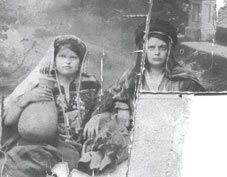

Oreet Ashery
Journey Palestine Israel
Experimental doc. | dv | color | 25:0 | United Kingdom, Israel | 2006
This video is a travel diary charting a journey made by Oreet Ashery in 2005 through Israel and Palestine. The journey features an Arab cleaner from Aram working at his parent's flat in Jerusalem; crossing the Qalandia check point; meeting a Palestinian friend in Ramallah; walking with his father in the Old City in Jerusalem; and a visit to Peqiin -the only indigenous village in Israel where Druze, Muslims, Christians and Jews live peacefully together. This video is a personal travel diary that aims to explore some of the complex issues around the conflict in the region, in particular, the positive connections between Jews and the Arab world, rather then what sets them apart.
Ashery is a London based interdisciplinary artist working in live and performance art, video, and other digital media. Ashery's work explores the relationships between personal politics and socio-political realities. Most recently Ashery's work has focus on the notion of Non/Returning, from political, domestic and psychological perspectives. Ashery's work is shown extensively in international contexts including; museums, galleries, cinemas, site-specific locations, and festivals. His work is also reviewed in art magazines, books, and academic writings.
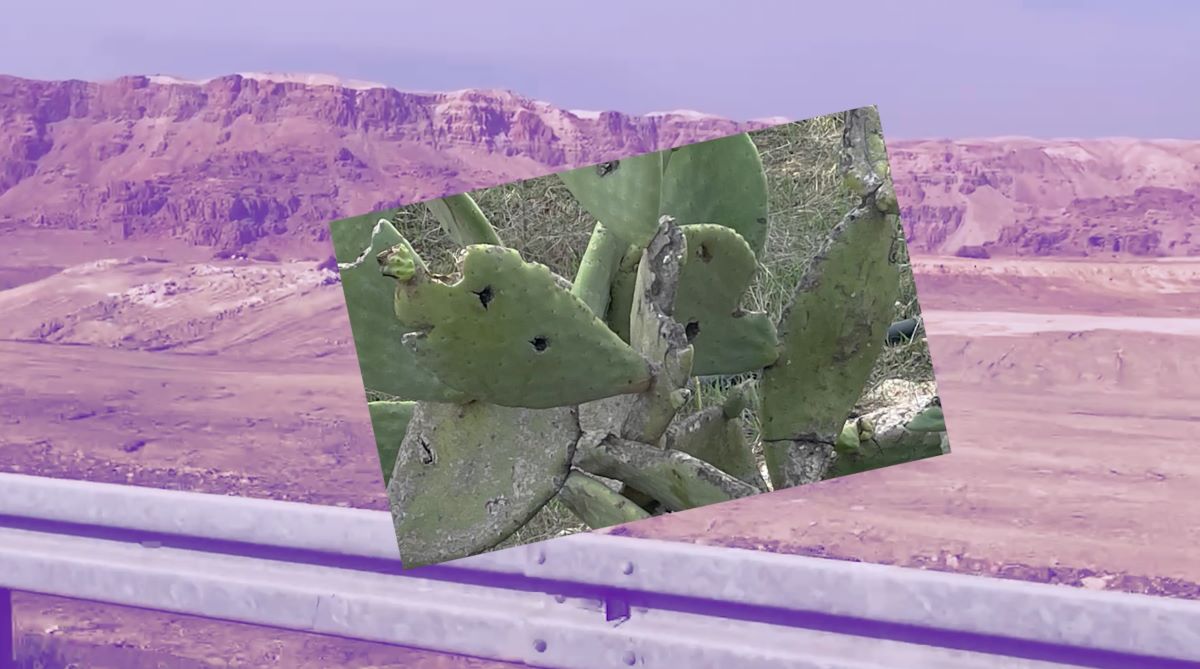

Oreet Ashery
Selfish Road
Experimental doc. | hdv | color | 30:48 | United Kingdom | 2022
Selfish Road (2022) A 30-minute film by artist and filmmaker Oreet Ashery. Journeying through their homeland and recalling autobiographical memories along the way, Ashery observes how both senses of belonging have and continue to fuse with the vertiginous and winding flows of nation-building, infrastructure and land use. Turning a camera onto the contested land in and around Jerusalem, Selfish Road draws upon the genres of science-fiction, stand-up comedy, the family photo album, and the implicit privilege of the slacker road movie. The film reveals a composite portrait of a rapidly changing landscape: roads collapse into sinkholes, diseased cacti line highways, and location-monitoring apps map circuitous routes to flag “high risk” and “prohibited” areas. This episodic reflection of space and place attempts to work through the paradox: How can you own something that is stolen? Selfish Road depicts a contradictory environment of industrial extraction obscured by spiritual wellness practices. With anger, grief, hope, and resistance, it dreams of material ecological visions for indigenous life away from settler occupation and seeks out an ethics in and beyond the beauty of the region. Commissioned by A KW Production Series. Text by Mason Lever-Yap
Oreet Ashery is a visual artist and an experimental film maker whose practice navigates established, institutional and grassroots contexts. The work engages with bodies, community, worldbuilding, autoethnography, Thanatos, gender and technology. Ashery’s practice manifests through distinct multiplatform projects that span video, 2D image-making, performance and assemblage. Characterised by the use of speculative fiction and humour, the work often occupies utopian, discursive and incongruous spaces. Ashery was a Turner Bursary recipient in 2020 (replacing the Turner Prize during the pandemic) and won the prestigious Jarman Film Award in 2017 for her web-series Revisiting Genesis, interfacing documentary and fiction and looking at the emergent field of digital death. In this context Ashery published her book How We Die Is How We Live Only More So, Mousse Publishing, 2019. Ashery is Professor of Contemporary Art at the Ruskin School of Art, University of Oxford


Asya Ashman, Konstantin Koryagin
Angel
Experimental fiction | digital | color | 14:55 | Russia, Germany | 2023
A couple in an apartment, antiquated interior. She suffers from a mysterious disease, sapping her strength and will. He takes care of her. As their fight against the inevitable seems increasingly futile, they resign themselves to the final measure. The film reflects on power dynamics, feeling of apathy and the quest to find one's place in the reality of impending societal catastrophe. This film was shot in the brief interlude between two profound catastrophes: the coronavirus pandemic and Russia's full-scale invasion of Ukraine. In January 2022, Asya and I got COVID-19 during a winter vacation in St. Petersburg, in the antique apartment where her grandmother, who passed away before Asya was born, once lived. A pervading sense of fatigue, ghostly echoes of past generations’ life, disturbing news that heralded the imminent outbreak of war, and a desire to find some way out of it all came together in a very strange foreboding atmosphere that we decided to capture. A few weeks post-shooting, as war erupted, we left Russia for Germany. The footage was edited in Berlin a year after filming.
Asya Ashman - dance artist and performer as well as a facilitator and creator of educational programs for young people. She was born in Moscow, Russia, 1994. She studied fine arts at BHSAD Moscow, and later focused on performance and dance. She is currently completing her degree in Dance, Context, Choreography at HZT Berlin. Since 2015, she has been creating her own artistic work, presenting it in various spaces (museums, theaters, parks, apartments) and working for other choreographers and artists. In her works, she explores artistic strategies to interact with personal and social issues, and question them through dance and spoken word, using humor, pop culture, magic, and collaboration. Konstantin Koryagin - independent researcher, video editor and filmmaker. He was born in Moscow, Russia, 1994. MA in philosophy, BA in political science. Since 2018 he is an editor of syg.ma – community-run media on philosophy, society and contemporary art. In 2021 he graduated the Moscow School of New Cinema, film directing laboratory. In 2023 he was a student at the Art and Media program at the Berlin University of the Arts (prof. Thomas Arslan). Currently based in Berlin.
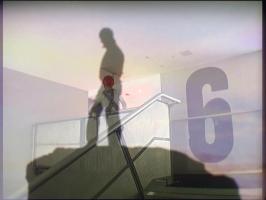

Jonathan Ashworth
Up twice
Art vidéo | dv | color | 3:30 | United Kingdom | 2005
Ascending the underside of a six story staircase, ?UP TWICE? is typical work of Jonathan Ashworth. He asks viewers to re-evaluate their perception of space, creating environments where people take afternoon walks on roof-tops and enter buildings through windows. Architectural details are put to use in unexpected ways that will turn your world on its head!
Qualifications 2004-2006 - Ma (Printmaking). Royal College of Art London 2003 - Ba (Hons) Tapestry / First Class Edinburgh College of Art 1999 - BTEC Diploma in Foundation Studies in Art and Design I Distinction Leeds College of Art Exhibitions and Commissions 2005 - ?Roncontres Internationales Paris I Berlin?. - Oriki ?Africa 05? Royal College of Art, London. Nov. - Drawing Projects? Campbell?s Art Gallery, London. October - BALTIC Centre for Contemporary Performance in collaboration with Platformnortheast, Newcastle. May - Black Hand? The Little Gallery, University of Calgary, Canada. February 2004 - ?Secret Postcard Show? Royal College of Art, London. November - Public Talk on Sosnowska at the Serpentine Gallery, London. November - Lecture at Claire College, Cambridge. November - Commission for Leeds Music Support Services. September - Private Tapestry Commission, Leeds. August - Henry Moore Conemporary Projects Programme I Collaboration with Olaf Nicolai Rotal Botanic Gardens, Edinburgh. May - Film Screening at Glasgow Art Fair. April - Private Tapestry Commission, Leeds. March - Artists House Opening Exhibition, Leeds. January 2004 2003 - ?[etis]? Solo Sow for EmergeD Space, Glasgow. December - Edinburgh College of Art Degree Show. June - Royal Scottish Academy Students Exhibition, Edinburgh. March - ?Novotel? Show at Magnifitat Space, Edinburgh. February 2002 - ?Going Continental? Heiligerkreuzer Hof Gallery, Vienna. May - ?The Supercentrofugolisation Station 1? at Protoacademy Space, Edinburgh. February
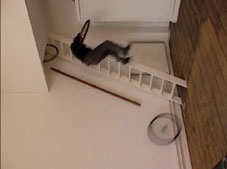

Caner Aslan
I am going to do what i am supposed to do
Experimental video | dv | color | 2:55 | Turkey, Netherlands | 2006
A man climbs a ladder to deliver a bicycle tire to another level. He climbs and climbs and climbs. It is a loop in which we see him climbing the ladder many times in a mood of strength of purpose. Ultimately he gets tired and takes a break on the ladder. And that starts the collapse that he already knows is coming. Tires start to fall and he jumps to his death. The fall of tires has a rhythm and a system. We can feel an absurd system or power that is capable of designing its own collapse. In a world where you are supposed to do something, what is the point of doing anything? Maybe the answer is in Myth of Sisyphus. The world is comprised of the absurd behaviour of a higher fidelity and hopeless labour in which you can find some hope.
Caner Aslan was born in Malatya in 1981. He studied graphic design at the Marmara University Faculty of Fine Arts in Istanbul. Now studying at De Ateliers which is a residency program for artists in Amsterdam.
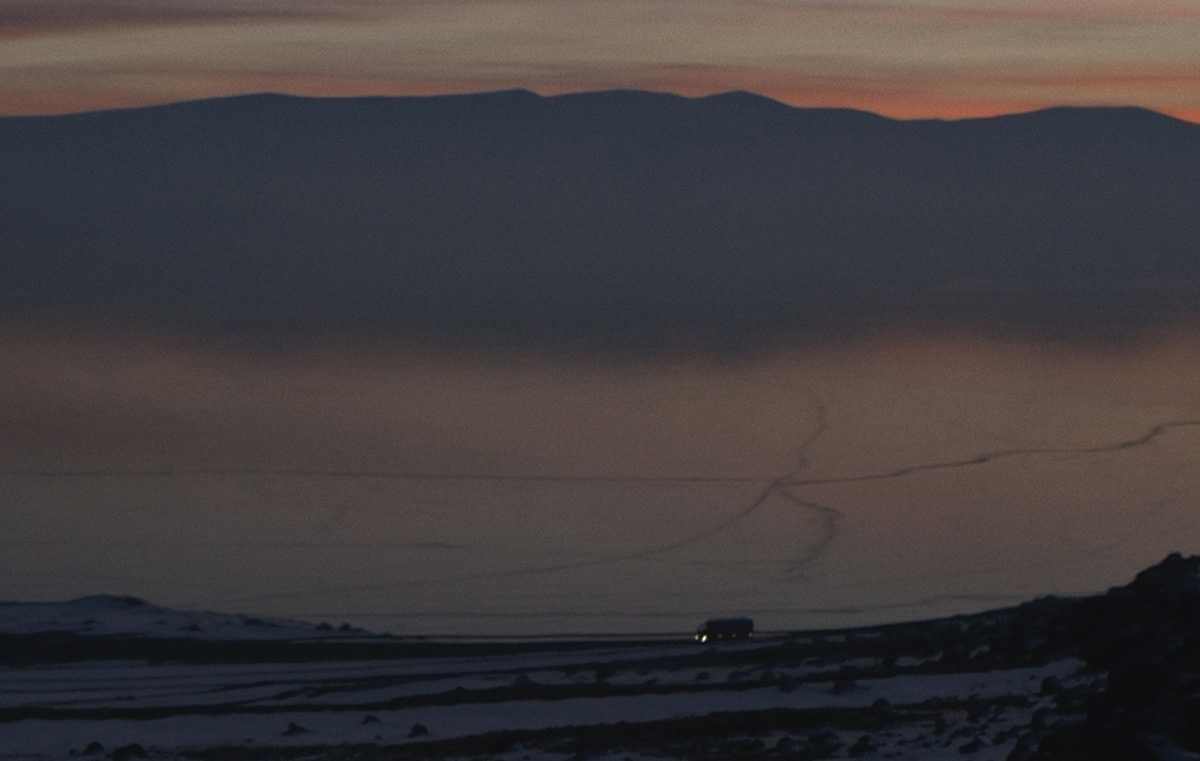

Tekla Aslanishvili
A State in a State
Experimental doc. | 0 | color and b&w | 47:0 | Georgia, Armenia | 2022
"A State in a State" is an experimental documentary film that follows the construction, disruption, and fragmentation of railroads in the South Caucasus and Caspian regions. It examines railways as the technical materialization of the fragile political borders that have re-emerged after the collapse of the Soviet Union. Revolving around the scenes of delay and waiting that constitute cargo mobility, the film reads the optimistic narratives about the New Silk Road against the grain. It observes how the iron foundation of connectivity can be used as a weapon of exclusion and geopolitical sabotage. Dotting the same lines, other forms of sabotage are deployed by workers to disrupt the political violence. Looking at historic and current practices of resistance, "A State in a State" explores the potential of railroads for building a different infrastructural consciousness and the lasting, transnational kinship among the people who live and work around them.
Tekla Aslanishvili (Born in Tbilisi in 1988) is an artist, filmmaker, and essayist based between Berlin and Tbilisi. She completed her studies at the Tbilisi State Academy of Arts in 2009 and holds an MFA from the Berlin University of the Arts in Experimental Film and New Media Art. Her experimental documentary films, texts, and installations emerge at the intersection of design, history, and geopolitics. They explore the shifting fault lines between governments, people, and their land through the lens of large-scale transit and energy infrastructure projects. Tekla is a 2018–2019 Digital Earth fellow, the nominee for Ars-Viva Art prize 2021 and the recipient of the Han Nefkens Foundation - Fundació Antoni Tàpies Video Art Production Award 2020. Currently, she is a postgraduate fellow at the Graduate School of the University of the Arts Berlin.
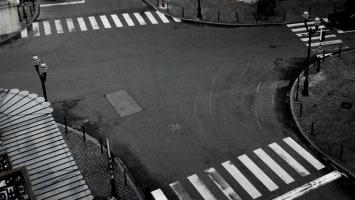

Herman Asselberghs
Altogether
Experimental doc. | 0 | color and b&w | 15:0 | Belgium | 2008
?The future is dark which is , on the whole, the best thing the future can be, I think.? With this observation as a starting-point, ?Altogether? fully acknowledges the ideological impasse of the post 68-era. The symbolic presence of flags and historical buildings, and of maintaining (national) capitals as such has become arguable; projected into the (near) future, they appear in a most uncertain light, and the cinematographic language underlines this: fragmented and associative, shot in black and white, the video shows sketchy images of urban scenery , some of them shot with a moving cell-phone camera on a car ride through Brussels. But what we actually see is a shadowy abstraction of a city which gives the impression of a negative space whose virtual character is no longer theorised using a voice-over, but can be found in the image itself. There is no speech, only sound. Approaching its climax, the film advances towards the collapse of the visible, leaving the viewer ?locked in? inside the current situation: fully aware of the (uncertain) future to come, wondering whether he or she will be capable of exerting any influence on it.
Herman Asselberghs (°1962) is an artist and critic. He regularly publishes on audio-visual culture and teaches at the film department of Sint-Lukas Hogeschool Brussel. He is a founding member of Auguste Orts (www.augusteorts.be) and Square (www.squarevzw.be). His installations and videos have been shown at Centre Pompidou, Paris; Dokumenta X, Kassel; Deitch Projects, New York; CGAC, Santiago de Compostella; h-artware, Dortmund; Witte de With, Rotterdam; Netwerk, Aalst; Muhka, Antwerpen; Van Abbemuseum, Eindhoven; International Film Festival Rotterdam; Internationale Filmfestspiele Berlin; FID Marseille; EMAF Osnabrueck; Medien und Architectur Biennale Graz, Rencontres Internationales Paris/Berlin en Transmediale Berlijn. He lives and works in Brussels, Belgium.


Herman Asselberghs
Capsular
Experimental video | dv | color | 24:0 | Belgium | 2006
The Spanish enclave Ciudad Autonoma de Ceuta stands midway between a city and an autonomous community with a Parliament and president of its own. Formerly an administrative part of the Spanish province of Cadiz, Ceuta, situated along the coast of Morocco, is now fully part of the European Union. This vanguard of European neo-liberal and xenophobic refugee policy acts as a contemporary version of the `Iron Curtain`. As a tangible construction this `Wall` between Europe and Africa is a precarious example of an extensive deportation annex security industry. As a symbolical line of fracture between North and South, between `inside` and `outside`, this enclave represents both the harsh reality of Africans looking for a brighter existence and the fantasy of Europeans beset and menaced by barbarism. With its `remote control`-policy Europe literally moves out its asylum problem: not only does it outsource the management of its borders to third parties, the Africans are also forced to participate in the fight against illegal immigration. The presence of asylum places bordering or even downright on African territory pushes the extent of the European borders far beyond their actual coordinates, turning the local authorities into watchdogs and hiding the migrant population from the view of the Western citizen. Capsular is a reflection on the relevance and irrelevance of images, on `the camp` as a symbol, a symptom. In the footsteps of his previous video work Asselberghs goes on another quest for an approach which plays on mainstream media, commenting on them and countering them.
Lives and works in Brussel publishes regularly on audiovisual culture curates concerts and multimedia shows for square teaches in the film department at Hogeschool Sint-Lukas Brussel is staff member of the Transmedia postgraduate program in arts, media & design at Hogeschool Sint-Lukas Brussel
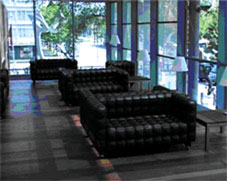

Herman Asselberghs
Proof of Life
Experimental video | dv | color | 35:0 | Belgium | 2006
The interior of an empty, open space: the borderline between ins and out is thin. Human presence can only be found on the sound tape: a male voice recalls horrendous TV-images, a popular disaster movie, a long-term imprisonment. The tile alludes to the diplomatic negotiating jargon for the video recording of a live hostage. After a.m./p.m. Asselberghs continues his search for an audiovisual approach, playing on the spectacle of mainstream media, commenting on it, countering it. Associative and suggestive (instead of formatted and explicit). The radical rift between sound and image reveals a film which needs to be listened to. A sound tape for watching. Or is this still-life possibly a self-portrait of the spectator?
Herman Asselberghs was born in 1962 and is an artist and art critic. He writes about audiovisual culture in de Tijd, teaches in the film department at the College of Higher Education Sint-Lukas in Brussels, and is also a member of staff with the Transmedia postgraduate. He is a founding member of Square vzw and a co-curator of [sonic]square, an ambulant concert series for electronic music. He published the book "Wrapped" with Els Opsomer and Rony Vissers, GCAC, 2000, and the essay compilation "Het Museum van de Natie. Van Kolonialisme tot Globalisering" with Dieter Lesage, Gevaert Publishing, 1999. His installations have been shown, among others, by the Centre Pompidou (Paris), Documenta X (Kassel), Deitch Projects (New York), hArtware (Dortmund), the Rotterdam Foto Biënnale and Muhka (Antwerp).
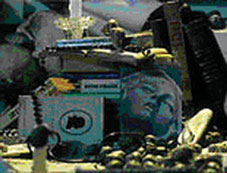

Herman Asselberghs
The Vanitas Record
Video installation | dv | color | 33:35 | Belgium | 2006
For the exhibition LocusLoppen, Koen Theys built a gigantic installation. "The Vanitas Record" was a three dimensional still life that measured 15 x 20 meters. Among the assembly of skulls, books, alarm clocks, and candles, Theys placed 20,000 living snails. In the first part of the same titled video - not a documentation of the installation, but a work on itself with different added contextual layers - the camera travels initially along the installation, showing in detail the books, crawling snails, buzzing (alarm) clocks, and extinguishing candles. Slowly, Theys adds a second layer of (self) relativity and (self) irony, inserting pieces from radio and television interviews he had on the occasion of building this 'record'. In the second part, "Vanitas Record" almost turns into a grand guignol as Theys blows up the already large press and public attention at the opening of his installation to the proportions of a mass event where visitors and press are led to roaring applause and a bombing of flash sounds. In doing so Theys exposes the reflective erosion with regards to the content of visual arts and culture in the press: the critical text is pushed aside more and more by the 'hype mechanism' in the media. Paradoxically enough this pompous act is at odds with the original reading of the content, imposed on the audience by a 'Vanitas setting': a call for justice and understanding for the temporariness in life and a warning for vanity.
Koen Theys was born in 1963. He studied at the Koninklijke Academie voor Schone Kunsten in Ghent, and Film and Video at the Hoger St.Lucas Instituut in Brussels. His work is mainly characterised by a fascination with objects depersonalisation. In his videos and pictures he often explores issues surrounding 'identity', in relation to the image in general and the digital image specifically. Many of his characters (e.g. Hitler in Media studies after Heinrich Hoffmann, or Picasso in Painting with Picasso) have in common that they are identified with an image, that they are cut loose from their underlying personality and reduced to an icon. His work is bought and shown all over the world, among others at the SMAK in Ghent; 'Le Casino' in Luxemburg, the MOMA and the American Museum of the Moving Image in New York, and MARTA in Herford, Germany.
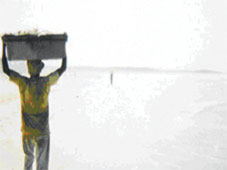

Herman Asselberghs
_imovie_[3] silver lips / for me
Experimental video | dv | color | 12:14 | Belgium | 2006
This third video letter from the imovie series - a reference to the Apple software Els Opsomer uses to explore and edit her picture material - makes use of images from Senegal. Similar to previous editions, there is a focus on the wide gap between the world at hand and the world far away, between the interior and the exterior. Everything revolves around the body of the loved one, waiting 'over there' for the right documents to travel 'over here' - a distance, a longing, too enormous to be true. Opsomer disects the difference between a body and a picture, between tangible and intangible, between representation and imagination, presence and absence. The photos are no longer investigated, but eagerly fondled, until nothing is left to be seen. Word and image, idea and reality, white and black seem further removed than ever.
Els Opsomer was born in 1968. She is a visual artist and graphical designer and was an artist-in-residence at the Rijksacademie in Amsterdam for some years. Together with such people as Johan Grimonprez, Herman Asselberghs, and Ronny Vissers, she set up a couple of multimedia-installations. She puts forward questions and comments on the complex reality we live in. Often she presents her work as survival strategies, mental aids assisting with the protection of the integrity of the human individual against the bombardment of reality. In the process she often makes use of her ever growing archive of photos and videos of city images, combining them with text and colour. Her work has been shown, among others, at the Werkleitz Biennial, the Centro Galego de Arte Contemporánea (Santiago de Compostella), MuHKA (Antwerp), and the Biennial on Media and Architecture (Graz). Opsomer works and lives in Brussels.
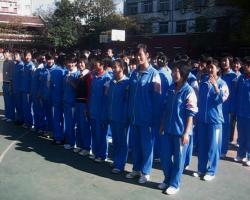

Christophe Atabekian
Tianjin Babies
Experimental doc. | dv | color | 76:21 | France, China | 2006
"Tianjin Babies" is a diary movie, made during a teaching trip to Tianjin, China, in autumn 2006, which fragments, recorded with a digital camera were posted on a video blog on day to day basis. On the other hand, in the first third of the film, I recorded in chinese four extracts from chinese texts by chinese contemporary authors I read in french during my stay and dreamed to share them with my then chinese friends.
Christophe Atabekian is a film director and teaches at the Beaux Arts of Tourcoing. He lives in Paris and tries to spend as much time as possible in China.


Sina Ataeian
Sand Storm
Video | 4k | color | 5:0 | Germany, Iran | 2022
I come from Ahvaz in southern Iran, the capital of the oil industry. As a child I played football outside in more than 50°C. Ahvaz was officially the hottest city on Earth. The city was just 80km away from the frontline of the Iran-Iraq war. According to independent reports, Saddam Hussein had used chemical weapons 387 times in that region during eight years of war. The chemicals were made in the Soviet Union, East and West Germany. The mustard gas killed combatants and civilians alike and remained in the soil. After the war, and due to global warming, the city slowly became hotter and hotter. The chemically poisoned soil slowly dried out. The wind came and swept the dust up into the air. The fine dust pollution in Ahvaz is 52 times higher than the maximum tolerable limit for one’s health. Around 290 days a year there is a thick haze mixed with chemicals called ‘Sand Storms.’ Ahvaz then officially became the number one in yet another area: The most polluted city on earth. The moment the oil is depleted Ahvaz will become a ghost town. A big wave of climate migrants. A tsunami of cancer! For most people, an apocalyptic environmental catastrophe is still something that is coming in the future. For us, people from Ahvaz, it has already happened.
Sina Ataeian Dena is an Iranian-German filmmaker and artist. Sina lectures at the national university of film and television dffb, UdK University of arts Berlin, and Filmuniversität Potsdam. His video arts and photographs were exhibited at prestigious contemporary art museums such as Hamburger Bahnhof, Villa Merkel, Künstlerhaus Bethanien, Kunsthalle Baden-Baden. In 2015, his debut feature film “Paradise” was nominated for Golden Leopard in the main competition of Locarno Film Festival, and won two awards, Ecumenical Church Award and Art Peace Award, among many other festival attendees and awards around the world. In 2016, he was awarded a scholarship from Goethe Institut Villa Tarabya Istanbul. In 2018 he exhibited his first video works in the modern and contemporary art museum Villa Merkel together with Francis Alys and !Mediengruppe Bitnik. Sina was Dramaturge and associate producer of the documentary “Seven winters in Tehran” Steffi Niederzoll which won Best film of Perspective section and the Heinrich Böll prize Berlinale 2023, F-ACT award at CPH:DOX Copenhagen among ongoing festival attendees and further awards.
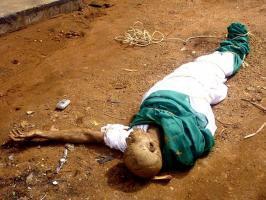

Jelili Atiku, Usuff Olawale Azeez
Victim of Political Assassination
Performance | 16mm | color | 30:5 | Nigeria | 2007
The Victim of Political Association was designed as a campaign to influence the Nigerian socio-political principles and modernize the logic that rules over them. In composition, forms and theme, it simply portrays a penetrating expression of the carnage in the act of political killings. The objects of the including human body (lifeless), shirt, Nigerian flag, political campaign poster, wristwatch, rope, clay-slip and mobile cell-phone, are brought together in an interactive manner to create sympathy, fright and enlist the beholders? minds in reflective thinking. They are laden with symbolic meanings: the slough body, wrapped and tied in Nigeria flag represents the carnage. The left hand is to depict the submission to the coarseness of the fatal fate of death. The robbing of the clay-slip is to represent the horrifying experiences, pains, sufferings and mental distress, which the victims must have gone through before; it finally gave up the ghost. The wristwatch and mobile cell-phone are symbol of the economic implications of the killings. The written words and the posters are to bring sociological statement. It should be noted that the five people in the performance are to define the state of mind (mood) of the bereaved and sympathizers.
Jelili Olorunfunmi ATIKU, renowned Nigerian human rights artist. Born in September 27, 1968 in Ejigbo, Lagos State, Nigeria he remains committed in creating art works that advocate for egalitarian society and human rights observance and promotion. Jelili had B.A (Hon.) Fine Art and M.A. Visual Art Specializing in Sculpture from Ahmadu Bello University Zaria and University of Lagos, Akoka, Lagos respectively. He is the Founder and Chief Coordinator of the Advocate for Human Rights Through Arts (AHRA), President, the Movement for Creative Drawing and Secretary II, Police Community Relations Committee, Ejigbo Chapter, Lagos Sate. In 2004 he staged an exhibition to campaign for Nigerian penal and prisons reform. The show was titled Shadows in the Dark, held at the National Museum Onikan Lagos. Similarly, in 2005 he had an exhibition of an installation sculpture, titled Ewawo: The Awaiting Trial Persons at University of Lagos, Akoka and Lagos State House of Assembly to campaign for the expunging of an obnoxious practice in Lagos State statuary book and Nigeria at large. The practice, which is known as Holding Charge is believed to be facilitating the over population of awaiting trial inmates in Nigerian Prisons to mention but few.
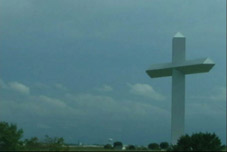

Hamdi Attia
Four sceens: in translation
Art vidéo | dv | color | 7:0 | Egypt, USA | 2004
A collage-based video work consists of 4 scenes. This is one of a series of video pieces that examine some aspects of verbal, visual, and textual layers of American culture. As an Egyptian artist living in the United States, I am trying to work with two visions in these videos -- the imagery and ideas I had from the American films shown on Egyptian television, and the disjuncture between those ideas and what I experienced upon coming here.
Hamdi Attia was born in Assiut, Egypt in 1964. He studied at the College of Fine Arts in Cairo, and pursued advanced studies in painting and sculpture at the Egyptian Academy of Fine Arts in Rome. Attia also received an MFA in sculpture from the University of Pennsylvania. He represented Egypt at the Venice Biennial in 1995, taking the top pavilion prize with Akram Al-Magdoub. His work has been shown in private and group exhibitions in Cairo, New York, Paris, Rome, and Philadelphia. He has also been commissioned for a number of public works in Egypt, Italy, and the U.S. Attia currently lives and works between Cairo and New York.
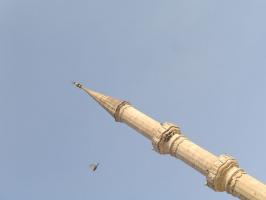

Kader Attia
Misunderstanding
Art vidéo | dv | color | 9:0 | France | 2006
« Misunderstanding » is a 9 minutes slide show on video showing about 80 pictures of different minarets. These images have been taken in Istanbul, a city situated where Asia, Europe and Middle East cross. The soundless bias and the regular projection of these pictures aim at giving them an hypnotic monotony, in a comforting lulling movement. Paradoxically, as these pictures have not been touched up, they bring us back to reality. The only effect created is a slight backwards or forward movement of the pictures, creating a deep movement. Pictures follow each other, silently, creating an ambiguity between a peaceful feeling, the beauty of a thousand-year-old architecture and the aggressive shape of the towers pointing at the sky like weapons. The manipulation of these pictures aims at creating a strange feeling between fear and fascination, dream and reality. Since the fall of the communist bloc, the geopolitical balance has switch from a two parts fight (Western countries against the Soviet bloc) to a multi parts fight between West and East religious worlds. Fantasies and fears have risen about ?the Muslim world?, which in fact gathers many different realities. Is there a huge misunderstanding regarding what we see through the mass media? Don?t we usually fear what we don?t know, what we don?t understand? ?The bigger a lie is, the more people believe it?. Is it the same thing that has happened with the massive destruction weapons that triggered off the recent events in Iraq? With few means, only a change of centring angle, a picture can tell complete different stories.
KADER ATTIA (born 1970 in Dugny/Seine-Saint-Denis). Attia?s past and life in a Paris suburb where the graves of the French royal dynasties are to be found and which is also a hotspot of inter-cultural conflict has had a decisive impact on his work. Using his own identity that has been defined by several cultures as the starting point, he tackles the increasingly difficult relationship between Europe and immigrants, particularly those of Islamic faith. In doing so he does not allow himself to be tied down to one specific medium. His photographic work and films portray the smouldering conflicts arising from the history of French colonialisation and are characterised by exceptional attention to detail. The allegorical minimalism of his sculptures and installations on the other hand is frequently unsettling owing to the discord between their external sensory appeal and their controversial content. He then builds installations questioning the viewer about his fantasies and phobias.
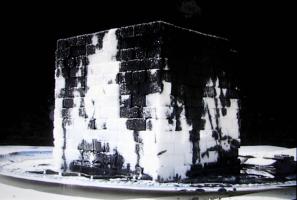

Kader Attia
Oil and Sugar
Art vidéo | dv | color | 5:0 | France | 2007
« Oil and Sugar » is a 5 minutes video which shows a white cube made of sugar on which black oil is put. Little by little, the cube ?drinks? the liquid, turns black and then falls down. The cube can be seen as a representation of the classical exhibition space (?the white cube?), as a symbol of a space for art. The more it becomes full of oil, the more it becomes black, the more fragile it becomes and then it is destroyed. It is an allegory of the "taboo" relationships between money, religion and art...
KADER ATTIA (born 1970 in Dugny/Seine-Saint-Denis). Attia?s past and life in a Paris suburb where the graves of the French royal dynasties are to be found and which is also a hotspot of inter-cultural conflict has had a decisive impact on his work. Using his own identity that has been defined by several cultures as the starting point, he tackles the increasingly difficult relationship between Europe and immigrants, particularly those of Islamic faith. In doing so he does not allow himself to be tied down to one specific medium. His photographic work and films portray the smouldering conflicts arising from the history of French colonialisation and are characterised by exceptional attention to detail. The allegorical minimalism of his sculptures and installations on the other hand is frequently unsettling owing to the discord between their external sensory appeal and their controversial content. He then builds installations questioning the viewer about his fantasies and phobias.

Guillaume Aubry
Mettre feu, mettre fin
Experimental video | hdv | color | 17:0 | France, Argentina | 2023
Following the description of Magellan's voyage in 1520, the archipelago in the extreme south of America, was named Tierra del fuego. The fires observed by the settlers on the surface of the water were those of the Yámanas, an indigenous people and seafaring nomads from this end of the world with a very hostile climate. Their lights have now completely disappeared with them, but glimmers of boats still persist in the middle of the fjords: the ferries which transport thousands of tourists each year from Punta Arenas to Cape Horn or from Ushuaia to a new El Dorado: the Antarctic.
Guillaume Aubry is an architect (co-founder of the Freaks agency), visual artist (Beaux-Arts de Paris) and doctor of art (Radian program). His thesis "Courser le soleil" focuses on the aesthetic experience of the sunset, the daily spectacle of the burning of the horizon. Today he continues his research by questioning our collective fascination with the end of the world.